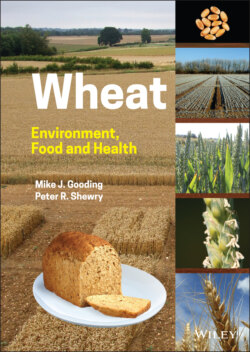Читать книгу Wheat - Peter R. Shewry - Страница 37
1.5 Grain Quality 1.5.1 Grain Size, Shape, and Specific Weight
ОглавлениеPlump grain is preferred for milling because it gives higher flour yields than thin grain. The reason for this is simple; plump grain has a higher proportion of starchy endosperm to bran. Conversely, well filled, heavier grain tends to yield less bran (Figure 1.21). The proportion of endosperm to bran is relevant to animal feed and alcohol production as well as to milling, because high starch contents are related to energy contents and alcohol yields, respectively.
Some of the scatter in Figure 1.21 may be due to cultivar differences in grain shape rather than purely grain size. More rounded grain with a less pronounced crease should give higher flour extraction rates (Evers et al. 1990). Genetic analyses and molecular studies of grain size and shape have been reported (Gegas et al. 2010; Brinton and Uauy 2019). These should allow selection for grain size and shape in breeding programmes but direct selection for these qualities, as opposed to yield, is not usually carried out.
Figure 1.20 Determination, using phenolic acids as biochemical markers, of the grain tissues proportions (aleurone, pericarp, endosperm), as a function of total flour extraction rate (durum wheat grains, cv. Ardente).
Source: Redrawn from Hemery et al. (2007) with permission.
Figure 1.21 Relationship between grain weight and bran yield for 150 wheat genotypes from a single field experiment. Bran yields are determined using a small‐scale laboratory mill and are therefore higher than those achieved by large‐scale commercial mills.
Source: Redrawn from Ward et al. (2008) with permission.
What has long been selected for, however, is grain‐specific weight, also known as the hectolitre (hl)‐, test‐, or the bushel weight (e.g. Reeves and Roy 1974). Specific weight is the bulk packing density of grain; it was originally used over 150 years ago in wheat buying and selling to estimate the weight of wheat in a grain bin. It is one of the most widely used measures of grain quality for two main reasons. Firstly, it is easy and rapid to measure. Assessment requires the weighing of a known volume filled with grain in a controlled manner. Secondly, it is loosely related to grain size, shape, and shrivelling (e.g. Clarke et al. 2004). Grain samples with large numbers of shrivelled grain may have specific weights as low as 40 kg/hl. In the UK, the highest prices for breadmaking quality wheat commonly require specific weights of at least 76 kg/hl, while for animal feed a lower threshold is tolerated (often around 72 kg/hl). Unfortunately, the relationships between specific weight and flour extraction rates are not close (e.g. Hook 1984), particularly for specific weights above 70 kg/hl (e.g. Evers et al. 1990). This is perhaps unsurprising as significant reduction in endosperm contents only occurs in markedly shrivelled grain (Evers et al. 1990). As well as grain size and shape, specific weight is affected by the density of individual grains, preharvest weathering, moisture content, wetting, drying, grain handling, and other factors influencing surface properties. In addition to the genetic component, specific weight is highly dependent on environmental conditions and crop management during grain filling (Chapters 3, 4, and 6).
